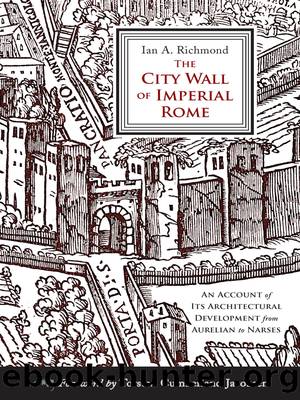The City Wall of Imperial Rome by Richmond Ian A.;Jacobsen Torsten Cumberland;

Author:Richmond, Ian A.;Jacobsen, Torsten Cumberland; [Richmond, Ian]
Language: eng
Format: epub
Publisher: Westholme Publishing
Above the stone curtain rose a barrel-vaulted brick-faced portcullis chamber, which received light from five round-headed windows at the back, and from as many at the front. All these are blocked, but their voussoirs are still visible. Three corbels, which held the hoisting machinery for the portcullis, still exist inside the chamber, and a diagram (fig. 23) of their arrangement156 is given herewith. It suggests that each side-corbel held a sheaf of pulleys, set with exactitude in a slot, and held by a large pin. Two triple sheaves contained in these would enable the heaviest portcullis to be raised with ease. The central corbel would hold ordinary pulleys for guiding to one capstan or hauling-point the two ropes passing through the side pulley-blocks. The machine would thus rise and fall gently and evenly, without the slightest danger of jamming, or of smashing the stops at the bottom of the slots in which it ran. These are dangers which would continually arise if each side were pulled by a different machine or squad of men. The device postulated was not novel to the late-Roman Empire. As early as the Augustan age, Vitruvius157 describes pulley-blocks with this very number of sheaves (pentaspastos). The brickwork of this chamber was not so good as that of the second period, and it was separated by a broken and irregular joint from the second-period brickwork in both passages leading to it. Evidently an earlier wall had been knocked back to that point in order to receive it, and what was removed was, no doubt, the first-period stone curtain together with the doorway leading into it, a removal which would leave the rough edge described.
Much worse is the brickwork of the third story. It is heavily patched inside, both at the back and the front, but enough traces of windows remain to give it for certain the five windows indicated by Vasi158 in front, while an equal number, now converted to loop-holes, are still visible in the rear wall. The chamber at this level is not bonded into the rest of the gate, as is the story below it, and its best work compares with that of the new fifth stories of the towers. It is therefore probable that the towers and curtain were heightened at the same time. That the curtain was not heightened before would explain why its decorative moulding was not arranged to fit the top of the quadrangular stories. The new chamber was arranged to have the same height as that below it, and so the curtain-walk above it happened to come opposite a half-landing. Thus direct communication with the rest of the Gate by means of a level passage was impossible. The curtain-walk was therefore reached by a small flight of stairs, into which was built a marble slab of Christian date, inscribed . Later still, an oven was built in between the stairs and the round tower. The rampart-walk slopes backwards sharply like that of Porta Ostiensis East. Otherwise its fittings
Download
This site does not store any files on its server. We only index and link to content provided by other sites. Please contact the content providers to delete copyright contents if any and email us, we'll remove relevant links or contents immediately.
Kathy Andrews Collection by Kathy Andrews(11343)
The remains of the day by Kazuo Ishiguro(8418)
Paper Towns by Green John(4812)
Spare by Prince Harry The Duke of Sussex(4806)
Industrial Automation from Scratch: A hands-on guide to using sensors, actuators, PLCs, HMIs, and SCADA to automate industrial processes by Olushola Akande(4633)
The Body: A Guide for Occupants by Bill Bryson(4599)
Machine Learning at Scale with H2O by Gregory Keys | David Whiting(3668)
Be in a Treehouse by Pete Nelson(3654)
Harry Potter and the Goblet Of Fire by J.K. Rowling(3619)
Never by Ken Follett(3550)
Goodbye Paradise(3463)
The Remains of the Day by Kazuo Ishiguro(3148)
Into Thin Air by Jon Krakauer(3135)
The Cellar by Natasha Preston(3080)
The Genius of Japanese Carpentry by Azby Brown(3045)
Fairy Tale by Stephen King(2976)
120 Days of Sodom by Marquis de Sade(2947)
Drawing Shortcuts: Developing Quick Drawing Skills Using Today's Technology by Leggitt Jim(2943)
The Man Who Died Twice by Richard Osman(2824)
